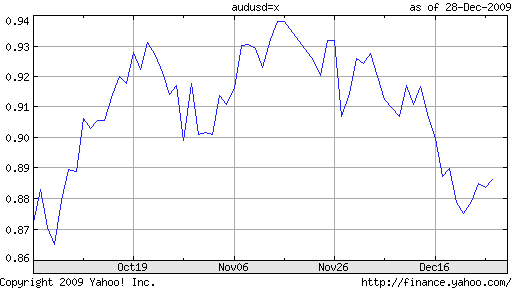December 29th 2009
Pause in Rate Hikes Threatens AUD
In October, the Reserve Bank of Australia (RBA) became the first industrialized Central Bank to raise interest rates. It followed this up with two additional hikes in November and December, bringing its benchmark rate to the current level of 3.75%, by far the highest among major currencies.
This series of rate hikes caught (forex) markets completely off guard, and investors moved quickly to price the changes into securities and exchange rates. The Australian Dollar initially spiked more than 7% following the first rate hike, bringing its total appreciation in 2009 to 32%- enough to earn it the distinction as the second-best performing currency, after the Brazilian Real. Beginning in November, however, concerns began to build that perhaps traders had gotten ahead of themselves, and the AUD has been in freefall since then.

Investors now fear that the RBA may have acted too hastily in hiking rates so soon and so fast. By its own admission, the RBA raised rates only after much deliberation: “The rate adjustment ‘would not be intended to slow demand compared with the current forecast path, but aimed simply at keeping the stance of policy appropriate for improving economic conditions,’ ” according to its own minutes. Since the recession was ultimately so mild (some would say ‘non-existent’) in Australia, however, the RBA ultimately decided that (pre-emptive) rate hikes were in order.
Now, interest rates are back in the “normal range,” according to a deputy governor from the RBA. In other words, the current rate is perceived as neither promoting nor hindering aggregate demand, which means it may not need to be tweaked much more in the near-term. In addition, there is growing concern that further rate hikes could trigger a cycle of deleveraging, because of the high debt burdens that plague Australian households and businesses. Household debt already exceeds 100% of GDP, which is even higher than in the US.
Besides, financial institutions are raising their own lending rates by wider margins than the benchmark rate hikes, so there is less impetus for the RBA to act further. Investors appear to have come to terms with this, as futures markets now reflect a 45% probability of another interest rate hike at the next RBA meeting, in February. This is down from 67% only last week.
If you’re wondering whether the RBA could be influenced by the lofty Australian Dollar when conducting monetary policy, it’s conceivable but not probable. It has already acknowledged that the carry trade is generally “back in vogue” and specifically targeting its very own Aussie, but that “As on earlier occasions, the economy has proven to be resilient to these [forex] swings.” If it turns out that the markets truly overestimated the pace of recovery (and by extension, interest rate hikes) in Australia, then the RBA won’t even have to worry about whether the economy can withstand further appreciation, since the AUD would probably remain fixed at current levels.



